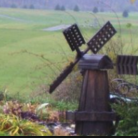
As we celebrate Father’s Day today, and my husband’s 70th birthday this coming Saturday, that barn seemed to be the perfect illustration of Ed’s character over the years. In fact, the day I saw the photo, and wrote this poem in a couple hours five years ago, I was waiting to bring him home from yet another hospitalization. Stalwart and steadfast, he’s remained standing no matter what life has sent his way… a true gentle giant. And like that barn, he’s faced many storms head on, never bending or collapsing as the winds attempted to shake his foundation. He’s remained firm with his faith in the Lord, resting secure in God’s provision and love, a pillar of strength for all of our family.
Yet, it hasn’t been easy. There have been some serious storms that sent waves crashing against him… and against us as a couple. Despite some plain old-fashioned trials, dashed hopes causing great disappointments, the loss of a daughter, and his losses of sight, physical strength and ability, he’s overcome those trials with an inner strength and peace that comes from his faith in the Lord.
And now, facing a continued ebbing of strength and ability with the progression of permanent muscle damage caused by statin/cholesterol drugs, and worsening congestive heart failure, we’ve begun discussing what we should do when he can no longer function and get around on his own. In all honesty, we don’t know what our options will be in the not-so-distant future. We’re facing new frontiers.
Still, through each difficulty, his and our faith has grown stronger, for we’ve learned “[We] can do all things through [Christ] who strengthens [us]” (Philippians 4:13) As I’ve said many times before, James 1:2-4 puts it so well, even though we don’t want to welcome another difficult challenge. “Consider it pure joy my brothers and sisters, whenever you face trials of many kinds, because you know that the testing of your faith develops perseverance. Perseverance must finish its work so that you may be mature and complete, lacking nothing.”
Being “strong in the Lord and in His mighty power” (Ephesians 6:10-13) is the foundation on which we survive great storms and come out standing. (Proverbs 10:25) … Just like that barn in Hugh’s photo. If we have a good foundation on the solid rock (Godly wisdom), weathered by time (experience), the structure (our character) will stand tall… and prove stalwart and unwavering.
The Stalwart
Linda A. Roorda
Stalwart and stoic through the test of time
Facing the world to weather life’s storms
Meeting head on whatever befalls
Humbly proclaiming, steadfast I stand.
~
Bringing together nature’s harmony
Weathered and worn, reliably true
Dependably there to meet others’ needs
Asking for nothing but structural care.
~
Like the pioneers who settled this land
And carved their place from wilderness wild,
Weathered by nature midst elements raw
They kept life sheltered from all threats and harm.
~
Without proper care, wood planks become warped
Foundations fail without wisdom’s base.
Oh, can’t you see! The meaning is clear!
How like old barns are patriarchs wise.
~
Learning through hardship true wisdom is gained
Taking a stand for what matters most,
Sometimes enduring alone in the crowd
Serene and secure midst turmoil and storm.
~
God bless the stalwart, unwavering friend
Who braves the path no matter the storm.
Of foe unafraid, on wisdom standing
Steadfast and loyal with comforting peace.
~~
- Read more...
- 2 comments
- 486 views


